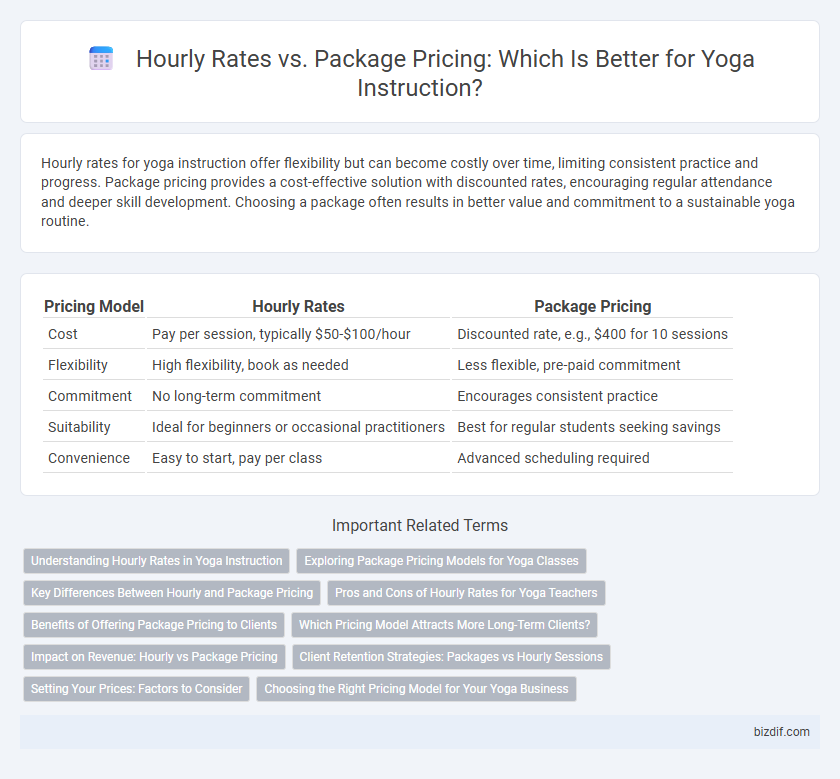Hourly rates for yoga instruction offer flexibility but can become costly over time, limiting consistent practice and progress. Package pricing provides a cost-effective solution with discounted rates, encouraging regular attendance and deeper skill development. Choosing a package often results in better value and commitment to a sustainable yoga routine.
Table of Comparison
| Pricing Model | Hourly Rates | Package Pricing |
|---|---|---|
| Cost | Pay per session, typically $50-$100/hour | Discounted rate, e.g., $400 for 10 sessions |
| Flexibility | High flexibility, book as needed | Less flexible, pre-paid commitment |
| Commitment | No long-term commitment | Encourages consistent practice |
| Suitability | Ideal for beginners or occasional practitioners | Best for regular students seeking savings |
| Convenience | Easy to start, pay per class | Advanced scheduling required |
Understanding Hourly Rates in Yoga Instruction
Hourly rates in yoga instruction offer flexibility by charging clients based on the duration of each session, typically ranging from $40 to $120 per hour depending on location and instructor expertise. This pricing model allows instructors to adjust fees according to class size, specialization, and additional services such as personalized corrections or meditation guidance. Understanding hourly rates helps yoga practitioners assess the value of tailored instruction versus standardized packages, balancing cost with the desired depth of practice.
Exploring Package Pricing Models for Yoga Classes
Exploring package pricing models for yoga classes reveals significant benefits in client retention and revenue predictability compared to hourly rates. Offering tiered packages--such as monthly memberships, multi-class bundles, or private session credits--caters to diverse student needs and incentivizes commitment. This strategic approach leverages discounted rates and value-added perks, optimizing class attendance and ensuring steady cash flow for yoga instructors and studios.
Key Differences Between Hourly and Package Pricing
Hourly rates offer flexibility, allowing yoga instructors to charge based on the exact time spent per session, which suits clients seeking occasional classes or personalized lessons. Package pricing provides a fixed cost for a set number of sessions, encouraging commitment and offering cost savings, making it ideal for clients aiming for consistent practice. Key differences include payment structure, client retention potential, and the predictability of income for yoga instructors.
Pros and Cons of Hourly Rates for Yoga Teachers
Hourly rates for yoga teachers offer flexibility and straightforward billing, making it easier to accommodate varying student schedules and class lengths. However, this pricing model can limit income stability due to fluctuating client attendance and may discourage students from committing to consistent practice. Unlike package pricing, hourly rates do not incentivize long-term engagement or provide predictable revenue streams for yoga instructors.
Benefits of Offering Package Pricing to Clients
Package pricing in yoga instruction encourages client commitment and consistency, leading to improved progress and retention rates. Offering bundled sessions provides better value perception and simplifies budgeting, enhancing overall client satisfaction. Instructors benefit from predictable income streams and reduced administrative time compared to hourly rate billing.
Which Pricing Model Attracts More Long-Term Clients?
Package pricing tends to attract more long-term yoga clients by offering discounted rates for multiple sessions, encouraging commitment and consistency in practice. Hourly rates appeal to beginners or occasional attendees but lack the incentive for sustained engagement. Studios that implement package pricing often see higher client retention and predictable revenue streams.
Impact on Revenue: Hourly vs Package Pricing
Choosing package pricing over hourly rates can significantly boost yoga instructor revenue by encouraging clients to commit to multiple sessions upfront, ensuring consistent cash flow and client retention. Hourly rates provide flexibility but often result in fluctuating income and less predictable revenue streams. Packages often increase overall revenue by creating value perception and incentivizing longer-term engagement with yoga programs.
Client Retention Strategies: Packages vs Hourly Sessions
Offering package pricing for yoga sessions significantly enhances client retention by providing a structured commitment and perceived cost savings compared to hourly rates. Packages encourage consistent practice, fostering stronger client-instructor relationships and increased loyalty over time. Hourly sessions may attract casual attendees, but packages deliver sustained engagement and predictable revenue streams for yoga instructors.
Setting Your Prices: Factors to Consider
Setting your prices for yoga instruction requires evaluating factors such as your experience level, class format, and local market demand. Hourly rates offer flexibility and clarity for one-on-one sessions, while package pricing encourages commitment and provides clients with a perceived value advantage. Consider operational costs, target audience willingness to pay, and competition rates to optimize profitability and attract loyal clients.
Choosing the Right Pricing Model for Your Yoga Business
Hourly rates offer flexibility and clear value for clients seeking occasional sessions, making them ideal for beginners or those with unpredictable schedules. Package pricing encourages commitment and generates steady revenue, appealing to clients motivated by long-term progress and savings. Selecting the right pricing model depends on your target market, session frequency, and business goals to maximize retention and profitability in your yoga instruction services.
Hourly rates vs Package pricing Infographic

 bizdif.com
bizdif.com